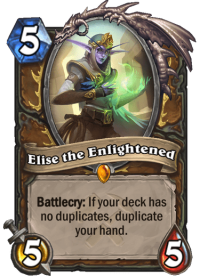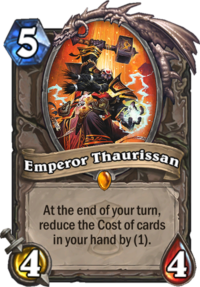While it may not have been without issues, the second expansion of the Year of the Dragon has clearly shown that the new leadership of Team 5 has a well-established vision for Hearthstone, one which resulted in a fairly positive gameplay experience on the ladder. Every class had Legend-viable decks and all archetypes were represented across the spectrum in the top tier of play – not bad considering they only have two expansions in the rotation which were developed entirely under their watch.
The Explorers’ Return
Say what you will about the power level of Priest, but the Saviors of Uldum metagame turned out to be a quite varied one, especially after the nerfs on August 26th. They were also unique in the sense that they didn’t intend to render the cards completely unplayable. Though the mana increase of Conjurer's Calling took out the archetype which it was synonymous with, the card itself remained a perfectly viable option in Highlander Mage, similarly to Luna's Pocket Galaxy. Meanwhile, Dr. Boom, Mad Genius remains a staple in Control Warrior and even Extra Arms retained its spot as a one-of in many Combo Priest builds.

It’s been a long time that we’ve seen an environment where each class had a viable ladder deck, sometimes more than one – and many of the new goodies from the set managed to muscle their way into the meta without feeling overly powerful.
A good example of this would be the four members of the League of Explorers, each and every one of which ended up seeing play already despite concerns about basically the whole quartet in the pre-release period. Though Zephrys the Great is the star, they all mesh well with the archetypes’ different game plans. Elise the Enlightened has great combo potential in late-game scenarios with Quest Druid, Dinotamer Brann provides crucial gas in the mid-to-late game, Reno the Relicologist is a brilliant stabilization tool and even Sir Finley of the Sands is beginning to see the light with the occasional aggro Highlander Paladin builds popping up around the place on the tail end of the meta.
Many of the decks in SoU also stretched what seemed possible with certain archetypes in general. For instance, Quest Druid was notable for having brutal enough tools to play a tempo game even after giving up so much tempo in the early turns. It’s also been interesting to see how most cards released in the Year of the Dragon seem to gravitate towards a playstyle where your hand size remains large throughout the game even if you’re playing a fast deck, creating a multitude of decision points along the way.
You could observe a similar trend of viability across the classes and the archetypes as well. From Control Warrior to Combo Priest, Battlecry Shaman and Tempo Rogue, you had the tools to reach Legend with any kind of preferred deck. Even Warlock had a tier 2 deck to work with in the form of Zoo, and its Zephrys-based iterations were surprisingly effective in certain pockets in the metagame. (As it turns out, Savage Roar is a heck of a card for a token-based deck with Life Tap.)
More… I Must Have More!
One of the crucial reasons behind the decline of interest in Hearthstone is that the playerbase became much faster at consuming content and solving the metagame. Stats-collecting sites, meta reports and ubiquitous decktrackers make min-maxing a very different proposition than it used to be in the days of Classic, and they all play a part in shortening the cycle from new content to stale metagame. It may have taken a long time for Team 5 to crack the code, but they found an ingenious solution, now able to shake up the metagame without having to print even more cards during a yearly cycle.

Buffing unplayable cards and returning staples from Wild to Standard for an event serve both as a shot in the arm for innovation and a way to spice up the power levels – crucially, sometimes even only on a temporary basis, allowing room for experimentation and potential overcorrection. Cards can get re-nerfed and moved out of Standard prematurely if necessary: it is a harmless and simple way to leverage existing content. While I’m personally not a big fan of power spikes in the rotating format, this is perhaps the nicest way to do it with the current toolset available in Hearthstone. While it’s not quite a permanent solution to the problem of not having enough things to do in the game for a veteran (even the 1000-win portraits only serve as a band-aid on an arterial wound), it’s a sign that Team 5 are finally taking the perspective of the remaining players into consideration instead of exclusively concentrating on new and returning ones with every content update.
Since there’s clearly only so much to iterate on the Dungeon Run concept (and the forced grind of the Plague Lords suggest to me that they really wanted to pump up the “hours played” metric for investor calls), it’s clear this won’t be the main avenue of innovation going forward. With tournament mode canned for the foreseeable future and further splitting up the playerbase with diminishing numbers being a dicey proposition at best, this is likely the most elegant approach they could go for in terms of refreshing the gameplay experience. (It’s also nice to see Tavern Brawls being used more aggressively as a testing tool, like the Wish-based brawl serving as a way to improve the Zephrys algorithm.)
The course correction in Arena is also welcome, though its ever-increasing focus on the casual gameplay experience is somewhat bittersweet from a veteran perspective. Regular set rotations are a nice way to spice things up, even if they make mastery almost impossible, and the abandonment of the bucket-based system is an important admission that the dev team was either unable or unwilling to invest the time and resources to update it on a regular enough basis (and with enough accuracy) to deliver on its initial promise. Removing bucket-based draft picks will shift the focus back to gameplay decisions from drafting considerations, even with micro-adjustments still playing a part in the overall experience.
While there are still many systemic issues concerning the long-term health of Hearthstone, and a lot will depend on the promised sweeping changes at the end of the Year of the Dragon, the change in approach is already notable and deeply felt, delivering great results inside a flawed structure. Whether the new leadership will manage to do just as well when it comes to changing the underlying parameters remains to be seen.

“…Returning to the rarity-based draft picks will shift the focus back to gameplay decisions.”
when did that happened? I hated the bucket system, it is good news for me.
Oh yeah, sorry about that, it was a mistake. We aren’t back to rarity-based picks, it’s just that card buckets were (experimentally) removed in this latest patch. It means that you won’t be offered 3 cards of a similar power level (dictated by Blizzard) at each pick – meaning that you can see e.g. a bad, an average and an amazing card in a single pick, just like it was back in the day.
When the change was first talked about by Iksar on reddit, it was commonly misunderstood as going back to rarity picking altogether, but he clarified it.
oh that’s alright, thanks for explanation Stonekeep! (:
Hello. I must say that I was longing for some article like this to show up. While what the article states is true and the metagame may deserve praise, I want to say that this expansion + plus one previous mini adventure have brought us what could possibly be the 2 worst cards ever printed in a card game. Addressing the elephant in the room we have the notorious SNIP SN4P and Zephrys the Great. Do you miss 4 dmg for lethal? Just play zephrys. The opponent has deployed a strong board? Zephrys. The player does nothing but click to play the card, the rest are done automatically. In the same fashion we have Snip Sn4p. Just play 100 Snip Sn4ps trade everything the opponent has, and make the game nigh unplayable in the turns to come. I wont even mention the repetitive animation and sounds one got to listen to as the Snip Sn4p player strives to get 67/67 on 3 of their minions.
Zephrys is not a problem at all because in order to always use him you cannot use more than one copy of a card, which severely hurts consistency of the deck. Having a good payoff for that is balanced.
Snip Snap is not an issue in standard because there is no way to get infinite. It is only a thing in wild and is not the only crazy combo possible in wild.
Zephrys is not a problem at all because in order to always use him you cannot use more than one copy of a card, which severely hurts consistency of the deck. Having a good payoff for that is balanced.
Snip Snap is not an issue in standard because there is no way to get infinite. It is only a thing in wild and is not the only crazy combo possible in wild.
Good article! What are the “sweeping changes” coming after year of the dragon? I don’t remember hearing about that.
https://www.hearthstonetopdecks.com/iksar-we-have-some-plans-to-remove-ds-but-it-comes-with-some-other-sweeping-changes/